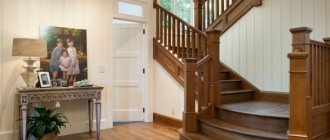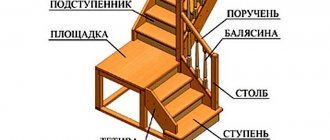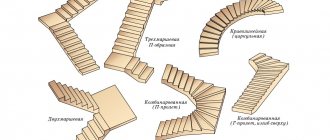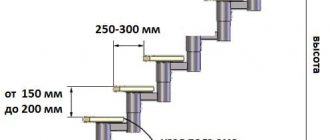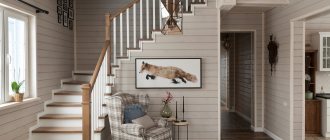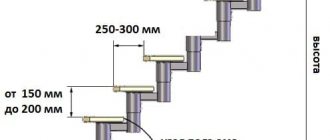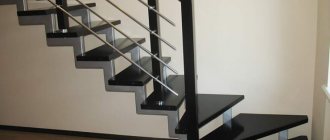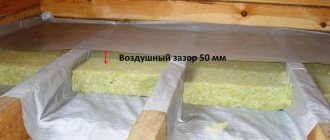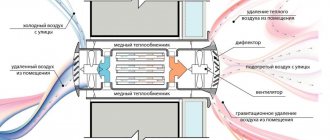Determining the required geometric dimensions
In order to correctly perform calculations, it is necessary to take into account certain geometric measurements. According to experts, three parameters are mainly important:
- height is the distance from the floor surface on the first floor to the floor surface on the second. To correctly determine the distance from the step to the ceiling, you need to take the height of the tallest person in the family and add 100 mm;
- the length is equal to the length of the march or the sum of all marches. At the same time, a staircase is added between them;
- width - the distance of the structure from the wall or the gap between two handrails.
In the diagram you can see the relationship between the angle of inclination and the steps
It is necessary to take into account the width of the marching structure:
- 1÷1.2 meters – will ensure comfortable movement;
- 1.5 meters – high level of comfort;
- 0.8÷1 meter can be used for a ladder installed against a wall;
- less than 0.8 meters – for auxiliary models.
Example of calculated data
The minimum permissible width for stairs with winder steps is 1.1 meters. The width cannot be less than 1.1 meters for a screw structure. The comfort zone starts from 1.4 meters.
The video below shows a simple way to calculate stairs:
Stair inclination angle (steepness)
The angle of inclination determines the ease of use of the stairs. A staircase that is too steep allows you to save useful space, but a flat one makes moving along it more comfortable. The type of staircase depending on the steepness is shown in the photo below. Here you can clearly see at what angle the staircase in a living room should be. The most comfortable option for movement is in the green one.
The diagram shows different angles of inclination
For your information! A staircase can be placed in a residential area only if the premises on the first and second floors are heated. If not, then the installation is carried out in a non-residential premises.
An example of calculating the length, calculating the height and width of staircase steps in a private house
One of the most important points is the correct calculation of the steps of the stairs. The dimensions should be such that it is convenient to move along the stairs. It is necessary to determine exactly what the height and width of the staircase steps should be.
The height of the step should not be too small so as not to disrupt the step. The optimal indicator varies between 150÷180 mm. The width of the tread should be such that the sole fits completely on it. The optimal option is from 250 to 320 mm. Often the tread is made with an overhang over the bottom step.
To find out the optimal ratio of width and height, you can use the following relationship:
2h + b = 600÷640, where
- h – step height;
- b – tread width;
- 600÷640 is the approximate length of a human step, or rather its average value.
Recommendations for step sizes
The disadvantage of the formula is that it does not take into account that the step width can be smaller or larger, and also does not take into account the slope of the march.
Step standards
To calculate the steps of the stairs to the second floor more accurately, use the special online calculator below, which uses other formulas.
Method of trigonometric calculation of step sizes
To determine the distance between the edges of the steps, the following formula is used:
G / sin 63° = (0.5 × L) / sin (27° + α),
Segment G is the hypotenuse in a triangle in which the legs are the width and height of the step.
From here:
- h = G × sin α= G × cos (90 – α);
- b = G × cos α= G × sin (90 – α).
But to find out the dimensions, it’s easier to use an online calculation of staircase steps.
Calculator for calculating the optimal sizes of steps of a flight of stairs
A simple way to calculate steps is presented in the video below:
Determining the optimal angle of inclination of the stairs
Almost all stairs have a slope of 45 degrees. The width of the step usually corresponds to foot size 45, but it should not be less than 30 cm.
Let's consider the main angles of inclination:
- for household stairs, the angle varies from 30 to 45 degrees;
- for flat structures and ramps – 30;
- for attached and steep options – 45÷75;
- utility ladders – more than 75.
There is a certain relationship between the steepness of the staircase and the location of its installation. The following relationship is used for the calculation:
D = H / tan α, where
- D – length of the horizontal projection of the stairs;
- H – height of the flight of stairs;
- α – slope angle.
General design rules
Often people who understand drawing well in a school course decide to create a drawing of a staircase on their own. This can lead to disastrous consequences if you do not know the established standards.
- The generally accepted limits of permissible slope are 25-40 degrees. If the value is exceeded 45 degrees, there will be significant discomfort when descending/ascending. This is true for stairs with winder steps. If the slope is expected to be less than 25 degrees (as intended by the designer or due to the characteristics of the building), it is advisable to equip the structure with a ramp.
- The recommended range of the number of steps in one flight is from 3 to 18. This limitation was created for safety purposes. If the structure is too long, there is a high risk of falling.
An example of the designation of the main parameters in the drawing
- Steps within the same flight must be identical in size and shape. This is due to the characteristics of the brain and muscle memory in particular. People rarely look carefully at their feet when going down stairs, mostly trusting muscle memory. If there are excellent steps at the end of the march, a person may “automatically” put his foot in the wrong position and, as a result, fall down.
- For external stairs, the door (located at the end of the flight) should open inward.
Staircase in a private house as an important element of planning convenience
When choosing a material and design, you must be guided not only by aesthetic preferences, but also by remembering safety and ergonomics. The following criteria will help you choose the right design and materials for the stairs:
- the location matters - in the center of the hall or as a secondary option in other rooms;
- dimensions and area for staircase construction;
- design safety level;
- the thickness of the walls to which the staircase will be mounted;
- the surrounding interior in the room where the structure will be located.
Ladder design diagram
There are special requirements and SNiP standards that must be observed. Before work, drawings and calculations are performed. For ease of calculations, various online staircase calculators are used.
The following technical requirements should be taken into account:
load-bearing walls must support the staircase structure; the supporting parts must be installed at a certain angle and on a special surface; it is important to maintain the recommended distance between steps; the railings must withstand a certain load of 400 N; it is necessary to maintain the correct distance between the bowstrings; there must also be the required distance between spans; the marches must have a gap and the same slope.
Main constituent elements
The main structural elements can be seen in the table below:
| Important components of a staircase structure | What can they consist of (options) |
| Basic structure | Bowstrings are side elements that support steps from the ends and bottom. They look like curved beams. They are installed at an angle. Stringers - support the steps at the bottom. Bolts - special bolts that help secure the steps and walls of the building. Support for the screw structure - a vertical stand on which all elements are fixed. Load-bearing parts can be made of different materials. |
| steps | The steps can be arched, winder, beveled or straight. The staircase can be two-flight or multi-flight. In this case, a step is mounted between the marches. |
| Fencing | Guardrails guarantee safe movement. These include the following elements: The baluster is a vertical post that supports the railing; The railing is used to fence flights and platforms; The handrail is an inclined element of the railing that is fixed on the balusters. Sometimes handrails can be mounted to the wall |
Basic elements, types of wooden stairs
- Stringer, bowstring - supports on which the steps are mounted. There are stairs on mono- and stereo-straps. As an option, without load-bearing beams - with support on steel fasteners (bolts) mounted in the wall.
- Steps consisting of a tread and a vertical element - a riser. Since risers have no practical function, marches can be made without them. With risers - a closed structure, without them - an open one. Ordinary treads form a march. Frieze - the outermost elements of the system, adjacent to the floor on the first and second floors. Winders - with a narrow outer part and a wide inner part, are used when designing turning and spiral staircases.
- Railings are fences made of vertical balusters and a horizontal handrail mounted on top of them. Installed along the outer edge of the flight as fall protection and a decorative detail.
Main types of stairs:
- screw - on a vertical stand, to which the winder steps are attached in a spiral. Such stairs are installed when there is little space. It’s better not to design them yourself. The most difficult thing is calculating the steps - the number, height, width of the tread and other parameters on which the convenience and safety of using the system depends;
- rotary - L-shaped with a rotation angle of 90º, U-shaped with a rotation of 180º. Less common are structures that change the direction of movement by 30, 40º;
- marching rectilinear - from one or two marches, separated by platforms. According to the geometry of descent and ascent, they are considered the most convenient of all types.
Straight, L-, U-shaped wooden flights on two stringers or bowstrings are quite easy to design yourself, especially if you are not limited by the size of the free space.
Take the test
Calculate a wooden staircase to the second floor
A simple online calculator will calculate the exact amount of building materials required for a wooden staircase. Start calculating right now!
Staircase calculation program, free calculation of steps, stair strings
The program for calculating stair steps will give you data not only on the number of steps required, but also the length of the stair string, the angle of inclination of the staircase, the height and depth of the steps, and the height of the stair riser. The step calculator may recommend that you reduce or increase the number of steps. And also the online staircase calculator will provide you with a summary of “convenient” or “not convenient” staircase according to the parameters you specified.
Convenient staircase. What is she like?
The convenience of the stairs is immediately affected by several parameters, such as the angle of inclination of the stairs, the height of the steps, the depth of the steps of the stairs, and in some cases even the width of the flight of stairs. Ideal step sizes are a guarantee of safety. The depth of the steps (step tread) should be about 28-30 cm (the size of an adult’s foot), and the height 15-18 cm. It is advisable to make the number of steps uneven so that the ascent and descent begin and end with the same foot. Having stepped onto the stairs with your right foot, you could climb onto the landing of the stairs with your right foot and vice versa, this is really more convenient. The height of the stair railings should lie above the center of gravity of an adult; with average height, the optimal height of the railing is 90 - 120 cm. The optimal angle of inclination for a straight wooden staircase is within 30 - 36 degrees. If the angle of inclination of the stairs is less than 20 degrees, then the staircase goes into the category of ramps; if it is more than 45 degrees, then into the category of attached, folding ones, where the descent is carried out only backwards; such stairs cannot be called comfortable, and especially not intended for daily use.
Drawing of a wooden staircase
In addition to all the calculations for building materials, the program will draw a drawing of your wooden staircase. Please note that the smaller the angle of inclination of the stairs, the more building materials will be required. Even at the design stage of a country house, it is necessary to decide on the parameters of the staircase and allocate enough space for the construction of a straight staircase.
Small solutions
If it is necessary to install a staircase that would not “conceal” the space and be as comfortable as possible, pay attention to small-sized structures. There are several types of such products that can meet the requirements of practicality and reliability.
Modular designs
When installing modular lifts on the second floor, you can experiment with the interior and choose different assembly options. You can make them yourself, which is the main advantage. Modular designs are screw, spiral, L- and U-shaped. They can also be rounded. The modular system allows you to give the staircase any shape in plan, and adding the required number of elements allows you to gain any height.
They are installed in openings of different widths and lengths. It is important to install the modular staircase correctly - the safety of residents depends on it. At the same time, attention is paid to the residence of persons with disabilities - children and the elderly - in the house.
Choose a modular staircase with a small opening to the second floor in accordance with the following recommendations:
- Before choosing, measure the area of the room and find out the dimensions of the opening.
- It is better if the structure is equipped with railings that will ensure safe movement.
- For ease of ascent and descent, choose stairs without risers - this ensures comfort when placing your feet.
- The design of the structure is created taking into account the overall style of the room.
Thanks to small platforms and compact turns, it is easy to save living space. First, they pay attention to the safety of the product and only then to its appearance. Modular structures are installed in a house where you need to move between floors quickly. Often this design is chosen for installation in a bathhouse.
Goose step staircase
Among single-flight structures, it is worth highlighting the “goose step” staircase. It does not take up space, but also does not restrict movement when ascending and descending. When changing the size of the march, it is important to maintain the optimal step width and slope range. If, even when choosing extreme values, it is not possible to create a rise to the second floor, it is not worth saving space for constructing a staircase.
The difference between the design is the alternate narrowing of the tread on each side. This allows you to create comfort when moving, while keeping the length of the march relatively short.
This design can become the highlight of the entire interior.
The goose step staircase is designed for comfortable movement in confined spaces. For such models, the optimal slope is 50° - 60°. Their width is reduced to 60-80 cm. Moreover, the ratio of the height of the riser and the width of the tread in such structures is quite unusual. If you transfer it to a regular one-flight staircase, moving along it would be unsafe.
Size of steps.
Recommended values.
Master Novitsky Oleg Vadimovich
in the book
“Modern stairs.
Design, manufacturing, installation. " (best recommendations to the author and this amazing work)
mentions the recommended and repeatedly tested values for the rise (h) and tread (a) of steps:
hxa = 150×300, 160×300, 170×290 mm
.
These dimensions are good, but unfortunately cannot be used if the house has already been built and the total height of the staircase (H) is not a multiple of the individual step (h).
In this case, we can turn to the calculation formulas:
Formula of convenience and formula of safety.
is widely known :
According to this ratio, the stairs will be the most convenient.
The stairs are considered safe
if the sum of dimensions (c) of the tread width and riser height is 45 cm (30+15, 27+18, 25+20).
Accordingly, this equation is called the safety formula
.
The difficulty is that these formulas are applicable in a small range of sizes and it is not always possible to implement the required proportion in practice. In this case, you should “get” into the indicated formulas with minimal deviation or use the universal Blondel formula, which takes into account the average step of a person. ( more details below
).
In special literature under the authorship of V.S. Samoilov. "Modern country house"
The following table is recommended:
Height and width of steps with different numbers of steps and slope
Please note: in single-flight staircases, as well as in one flight of two- and three-flight staircases within the first floor, no more than 18 ascents (steps) are allowed. Maximum step height 220 mm
(SNiP 21-01-97)
The maximum step height is 220 mm. (SNiP
21-01-97)
To design a simple wooden staircase on stringers, measure the height between floors (vertical distance from the floor of the lower floor to the floor of the upper).
By the way, the height between floors is the most “sick” size. In houses made of stone, deviations from the design by 4-5 cm are often encountered, and wooden ones are subject to shrinkage and shrinkage (up to 15 cm per floor). Ideally, you should wait until the log frame has completely dried out over several years.
Also, it is better to take the dimensions for calculating the stairs when the finished floors are laid or clearly set the horizontal height levels.
So, let the height in our case: H = 278 cm
.
Choose the height of the riser: let h = 18 cm
.
By dividing the height between floors by the height of the risers, the required number of steps is obtained: 270. 18 = 15
To determine the optimal width of the step, use the convenience formula. a - h = 12. h = 18 cm.
Convenient tread width:
a = 12 + h = 30 cm.
Therefore, 15 steps with a width of 30 cm and a length depending on the width of the opening in the interfloor ceiling are needed.
Let's check the stairs using the safety formula: a + h = 46 + 3
cm
In this case: 18+ 30 = 48
cm.
The ladder is safe and easy to use.
( This example of calculations is given by Stolyarov A.N. "Building stairs."
)
A French architect and engineer back in 1672 proposed the following ratio:
in which S is the average human step, which lies in the range of 600 - 640 mm
.
That. Blondel's formula can be transformed into the following inequality:
600
The lowest acceptable result for practice will be min. step rise:
h = 120 mm, a = 400 mm, slope 17 degrees.
With a smaller angle, it is no longer a staircase, but a ramp (ramp) - a gently sloping platform.
h = 220 mm, a = 200 mm, slope 48 degrees.
At the upper limit of the Blondel formula, the result is not the most convenient staircase, suitable for use only when moving towards the steps.
Going down the stairs is more dangerous than going up, so ease of use is assessed on the way down.
An example of a master’s thoughts according to Blondel’s formula:
We measure the height between floors H = 3050 mm.
We determine the rise of steps h by dividing H by the possible number of rises (n).
With 17 lifts: h = H / n = 3050 / 17 = 179.4 mm.
At 18:
h = H / n = 3050/18 = 169.4 mm.
At 19:
h = H / n = 3050/19 = 160.5 mm.
Next we calculate the stroke line: A = 5000 mm
The length of the travel line should not be less than the height between floors (H) ( otherwise the staircase will be impractically steep
).
In our example: A (5000) > H (3050)
With n = 18
tread
a = 5000 / ( n - 1 ) = 294mm.
(n-1)
The actual number of steps is 1 less than the calculated value. This fact is easy to accept if the first step is considered at floor level.
Blondel step parameter: 169 x 2 + 294 = 632
. Therefore, the size is acceptable, organic and lies within the average human step.
That. We have determined the width of the tread and the height of the riser for easy movement, but this is not enough to build a comfortable and safe staircase.
The line of progress (A) was just mentioned in the reflections. Let's take a closer look at this and other parameters that need to be taken into account when designing a staircase.
Parameters of a staircase with a 180 degree rotation
Rice. 1 General drawing of the stairs
Rice. 1 General drawing of the stairs
- Y - opening height - usually determined by the height of the floors of your house
- X - length of the opening - depends on how much space you can allocate in your house for a staircase
- E - width of the stairs - depends on how much space you can allocate in your home for the stairs
- Z - thickness of steps - geometric parameter of the material (for example, boards) from which you plan to build the stairs
- F - step protrusion - the distance by which the upper step will hang over the lower one
- C - total steps - how many steps will it take for you to most comfortably move from floor to floor
- P - steps on the lower string - the number of steps to the landing depends on your preferences and the geometric characteristics of the house
Rice. 2 Designation of steps
"Show risers: H" function
Fig.3 Execution of stairs with risers
You can build your staircase with or without risers. This function allows you to see what the design will look like with both options.
Function “Upper step below the floor of the 2nd floor: SP”
Rice. 4 Execution of the staircase, with the top step below the floor of the 2nd floor
Depending on the relative placement of the structure and the floor of the upper floor:
- The upper plane of the top step is flush with the plane of the floor of the upper floor;
- The upper plane of the top step is lower than the plane of the floor of the upper floor by the height of the step.
The choice of one or another mutual placement may depend on: the thickness of the interfloor ceilings, the desired relationship between the number of steps and their height, the length of blanks for stringers and the length of the opening, the desired angle of inclination of the stairs, or simply the tastes and preferences of the owner of the house
Please note that in the figure in which the upper step is below the floor of the 2nd floor, the thickness of the interfloor ceiling is greater than in the figure in which the upper step is at the floor level of the 2nd floor. If the thickness of the ceiling is less than the height of the step, the stringer simply will not rest against the ceiling (therefore, when demonstrating the second option, this thickness had to be increased)
Function "Black and white drawing:"
Rice. 5 Black and white drawing of a staircase
It is advisable to use this function in two cases:
- If you are used to working with standard GOST drawings, and, accordingly, better perceive graphics without color content.
- If you are going to print the results of the calculator. Then you will spend less paint/toner and the visual perception of the drawings on paper will be better. And, of course, this function is used when printing on a black and white printer.
Function "Change lifting direction: LR"
Rice. 6 Type of stairs with different directions of ascent
A specific staircase, which is placed in a certain way in the house, can be approached from the side from two sides or only from one side - when the staircase is in contact with the wall. In the latter case, there are two options for placing the structure relative to the observer:
- Rise from left to right;
- Ascent from right to left.
This function allows you to visualize both of these options.
Classification of stairs
The design of the staircase depends on its type. The generally accepted classification identifies the following types:
- Straight stairs. The simplest type in terms of design and installation. One of the main advantages is simplicity and safety of operation (subject to compliance with all building codes). The only drawback is the large dimensions. Therefore, straight stairs are built mainly in commercial buildings (shopping centers, theaters, etc.).
- Turning stairs with a platform. Such structures are erected in order to reduce the occupied space and increase the level of comfort and safety of the room. The turntable provides additional convenience due to the fact that several people moving in different directions can disperse on it. It also makes lifting heavy objects easier. The rotation is carried out 90 or 180 degrees, but there are more creative options.
- With winder steps. The variety is similar to the previous one, with the difference that steps are installed instead of platforms. The treads have the shape of a truncated triangle. This technique saves space. Designs with winder steps have an elegant appearance. The main disadvantage is the complexity of design and installation.
Examples of diagrams for stairs of various configurations
- Screw. The most compact designs, used mainly in small buildings. Also, spiral staircases are used as an addition to the main one.
Important: spiral staircases are recommended for use with opening sizes up to 3 m.
- Radial and curved structures. The most difficult types of stairs to design and install. Characterized by non-trivial shapes and intricate lines. Only professionals can handle the installation and drawing up the drawing.
A few more recommendations
If we conduct another small educational program, we should talk a little about the interdependence of the geometry of the stairs and the height of the floors. Height is the difference between the level (mark) of the finished floor of the lower floor and the upper one. Thus, when you calculate the height of the floor yourself, do not forget to include the thickness of the finishing (screed, ceramic tiles, parquet or linoleum, etc.). In the design of private housing, the most common floor height is considered to be 2.8 or 3.0 m, as well as 2.7 or 3.3 m (the main thing: more than 2.4 m and a multiple of 300 mm). With the specified heights, you can easily place the stairs in your living space, and the accepted dimensions of the steps will meet safety standards.
It is important to take into account the thickness of the floor and finishing, if any, in the drawing. When the floor height in your home is different from the standard, you will have to calculate the size of the steps yourself with millimeter accuracy
Do not forget about parameters such as a safe angle of inclination. Also, make sure that all risers are the same height. Stepping up stairs with different step heights can be dangerous, so it is better to add all roundings during calculation to the size of the bottom fascia panel
When the floor height in your home is different from the standard, you will have to calculate the size of the steps with millimeter accuracy with your own hands. Do not forget about parameters such as a safe angle of inclination. Also, make sure that all risers are the same height. Stepping up stairs with different step heights can be dangerous, so it is better to add all rounding during calculations to the size of the lower fascia panel.
To round sizes, you can use a special podium step.
Calculation of the stairs to the 2nd floor using an online calculator
There are many online calculators on the Internet that make the task of calculating stairs as easy as possible and quickly resolve all issues.
The basis for programs for online calculators are the requirements for staircase structures and standards regulated by GOST. An example of one of the good calculators is zamer-doma.ru.
It works simply, just enter data such as the height, length of the opening, number, thickness of steps, height of their edges, maximum width of the stringer, as well as the direction of rise and orientation of the first step relative to the floor of the 2nd floor to get:• a drawing of the staircase;• length the upper bowstring;• the angle of inclination of the structure;• the size of the step between the cuts under the steps on the bowstring;• the height and depth of the steps;• the height of the understep;• recommendations for changing parameters to increase the comfort of the stairs.
Staircase parameters required for calculation on the calculator
Another free online calculator is lestnicmir.ru. With its help, you can calculate the most appropriate design and receive recommendations for improving its ergonomics.
To do this, you only need to select the type of staircase, enter the required overall dimensions and data on the steps, the calculator will do the rest itself.
Sketch for calculating a staircase with a turn
Estimated dimensions of the stair string
A good staircase calculator domaizbrusa-pestovo.ru
It is easy to use - you just need to pay attention to the prompts and enter the parameters required by the system
This online service allows you to perform structural calculations. There is also a material calculation calculator here.
The program will also produce a drawing of the staircase, where the main dimensions will be indicated, the markings of the upper points of the steps on the string, the angles at which the steps are located relative to the string, and other defining dimensions.
Calculator for calculating stairs domaizbrusa-pestovo.ru
The o-builder.ru calculator will quickly calculate a straight staircase
Standard elements.
Every good owner knows how to count money. The construction of stairs is no exception. You can save a lot of money if at the design stage the details of the staircase can be adjusted to the standard of blanks accepted in our country.
Economic considerations can be the key argument that allows the owner to choose a single staircase location option from several possible ones.
Stage standards:
Available with fillet R 12.5. Invitation steps: H 220 x 400 x 1200, R200 and H220x400x1400, R200
A triangular winder step of non-standard size is calculated to order as rectangular ( the necessary part is simply cut out of it)
). Therefore, it is advisable to order rectangular ones. The cost is identical, and the trimmings will be useful in the work.
Large steps can be made from furniture board sizes: 38 x 400 x 2000, 38 x 500 x 1500, 38 x 500 x 2000, 38 x 700 x 1500, 38 x 1000 x 1000, 38 x 1100 x 1100, 38 x 1200 x 1200 The same shields can be used for landings.
Available in 18 mm thickness. Width: 180 and 120 mm. Length: 900, 1000, 1100, 1200, 1300, 1400 mm.
Available in 18 mm thickness. Dimensions: 200 x 2000, 300 x 2000, 350 x 1000, 350 x 1500, 350 x 2000, 350 x 2500, 350 x 3000, 350 x 3500
Section: 80x80, 100x100.
Length: 1200, 2000, 2500, 3000.
Naturally, other sizes are possible upon request.
Standards: 40 x 350 x 2500, 40 x 350 x 3000, 40 x 350 x 3500, 40 x 400 x 4000, 50 x 300 x 3500, 50 x 350 x 3500, 50 x 400 x 4500
Sections: 40x70, 45x70, 45x80, 45x90, 60x60, 70x70, 70x90, 80x100
Length: from 3500 to 6000 mm.
Round diameter: 30 and 47 mm.
Square part of others: 40x40, 45x45, 50x50, 60x60, 70x70, 80x80,
Diameters: 75, 95, 115, 140, 145 mm.
In addition, it makes sense, even at the calculation stage, to familiarize yourself with the price list of the nearest supplier within walking distance.
So, it’s not the gods who burn the pots! We hope we have somewhat succeeded in dispelling the myth that the design and construction of stairs is accessible only to a select few. Read the articles, literature to which we referred in this text, take measurements, sketches and drawings.
In essence, the bottom line is that the task looks simple: Based on the layout of the house, the location of the stairs, the aesthetic preferences of the owners, you need to calculate the parameters given in this article, which must be organically included in the standards for comfortable and safe movement around a country house or multi-level apartment.
Comfort and goodness to your home!
Features of structural calculations
Thanks to our resource, you have already been able to familiarize yourself with the types of staircase designs and the main building materials used for their manufacture. In a residential building, the most common are staircases made of wood, less often - metal or reinforced concrete structures. Before you begin the element-by-element design of a staircase with your own hands, you need to estimate the length of the flight of stairs, select the material and calculate the load-bearing capacity of the staircase frame.
Even a complex, at first glance, structure can be assembled independently without any problems if you approach this issue correctly.
To determine the load-bearing capacity, it is customary to divide the entire structure into individual beams - necessarily statically determinable. Depending on the type of pinching of the flight of stairs - rigid on both sides, hinged, and maybe even cantilevered - a formula is selected to determine the main force factors
What is especially important to consider when calculating a structure with your own hands? Walking and running up stairs is a unique type of dynamic impact, even if it is minor. Therefore, the supporting structures of the stairs must have sufficient rigidity, which will ensure a deflection of no more than 1/400 of the span
The total load (permanent + temporary) on flights of stairs and landings of a residential building should be no more than 300 kg/m2.
Methods for attaching support stringers of a wooden staircase to a landing beam.
Carrying out staircase installation work
The second stage involves construction and installation work, for which you will need previously purchased materials and available tools:
Selection of the necessary tool for the job
- Drill, brace - for making holes for hardware;
- Hacksaw for cutting wood or electric saw;
Advice: It is better to have two, one with a large tooth, the other smaller, with two-millimeter teeth.
- A screwdriver and bits for it, which will be used during installation according to the do-it-yourself ladder fastening diagram;
- Chisel;
- The hammer is “light”, weighing up to 200 g;
- Planer for processing and fitting parts;
- Sandpaper for sanding steps and handrails;
- Measuring tools – tape measure, level, ruler;
- Bolts or screws for fastenings. They can be purchased at a furniture fittings store or at the construction market;
- And also a pencil and gloves for work.
At the exit we get a bolted wooden staircase.
The correct choice of materials plays a very important role in this situation. Wood for these purposes is selected first grade, preferably from aspen or pine species. Determine by weight how high the moisture content of the board is by holding it in your hand. For work, purchase ready-made planed wood that does not have particularly large knots or burrs.
Tip: make sure that the location of the knots is no more than 1 piece per meter of the board.
You should first consider how the stair switch circuit will be located, what the width of the flight of stairs will be, and whether you need carved railings. The answers to these questions will allow you to calculate everything in advance and save money, but on the other hand, you cannot take savings to the point of recklessness and sacrifice safety.
First of all, we advise you to plan the stringers from 140x60 timber, and then make the required number of steps from a board, the thickness of which should be at least 30 cm. Plan risers for them from the same material, or slightly thinner boards (up to 25 cm).
Assembling the stairs
Recommendation for owners and builders: before you start assembling the finished construction set, it would be a good idea to try on the parts and, if necessary, adjust them. The same applies to the design of metal stairs.
This is the result you can get.
Let's look at the entire assembly and installation process step by step:
- Sand, clean and restore steps, railings and risers to normal condition. Particular attention should be paid to the ends;
- Using stain (or hot drying oil) and wood varnish, the product is coated in two or several layers, as required by the instructions for the varnish. Cover the joints with tape so you can apply glue there later;
- Now, using a screwdriver, we fasten the surfaces together, having previously coated them with glue. In the work, use only stainless screws, and both carpentry and ordinary PVA glue are suitable as glue;
- Start cutting grooves for the steps in the stringers. Here they use a chisel and connect a hacksaw;
Scheme for assembling a serial wooden staircase
- Holes for bolts with a slot for a splined bit are drilled in the grooves. The hole diameter is usually 9 mm;
- Insert the steps into the grooves, using a pencil to mark the place for the bolt through the hole;
- Take out the stage and drill a hole for the turbo coupling for the M8 bolt. Hole depth 3-4 cm;
- First, the turbo coupling is screwed into the stage, and then the structure is placed in the groove and secured with a bolt;
- Using the same scheme, ready-made railings are attached, cut from timber and assembled separately from the steps.
The chosen type of fastening of the steps is distinguished not only by the price, but also by the reliability of the connection of the parts: the staircase will serve you for many years. You can also use furniture screws, for this purpose preparing the hole in the step a couple of millimeters smaller.
The photo shows how to fasten elements together using a screwdriver
The result should be a finished staircase that can be easily assembled yourself, or you can hire a couple of workers for this work. As for the beautiful carved staircase balusters in the railings, their owners often order them from carpentry shops to order, matching the shade to the color of the staircase steps, and then install them as required by the staircase assembly diagram.
